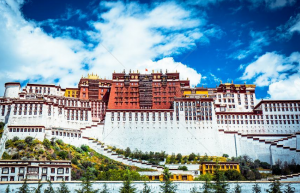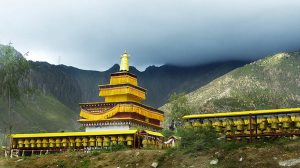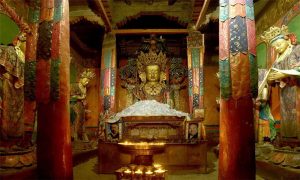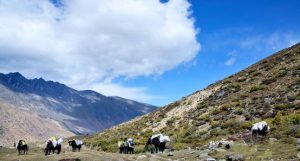9 Days Tibet Culture Tour with Mount Everest Base Camp

Tour Overview
This 9 days Tibet Culture Tour with Mt. Everest Base Camp is based on the most popular travel route of Mt. Everest. In addition to some must-see attractions, like...
Code of Tour: YCT0000003519
Length of Travel: 9 Day
Destinations of Tour: Lhasa - Gyangtse - Shigatse - Sagya - Mt.Everest - Shigatse - Lhasa
Departure City: Lhasa
Price of Tour: Request
Type of Tour:
Features of Tour: Hiking Culture Minority Landscape
This 9 days Tibet Culture Tour with Mt. Everest Base Camp is based on the most popular travel route of Mt. Everest. In addition to some must-see attractions, like Lhasa, Gyantse, Shigatse and Mount Everest, we intend to experience Tibetan traditional art, such as Tangka painting, Tibetan incense & blanket production and Tibetan medicine. Moreover, you will visit a school at the foot of Mt. Everest and chat with children to learn about their daily school life. This tour is designed especially for students, which will enlarge your travel experience and you can learn a lot of different things at the same time.
Highlights:
- Experience Tibetan Buddhism in significant monasteries in Lhasa and Shigatse.
- Visit the highest monastery and highest school in the world.
- Enjoy the starry sky and stunning sunrise of Mt. Everest.
- Meet the tranquil lakes, white snow mounatians, shimmering rivers and rare animals along your way.
Brief Itinerary
- Day 1: Lhasa Arrival
- Day 2: Lhasa
- Day 3: Lhasa
- Day 4: Lhasa-Gyantse
- Day 5: Gyantse-Sakya
- Day 6: Sakya-Tashi Zong Village
- Day 7: Tashi Zong Village-Rongbuk Monastery
- Day 8: EBC-Shigatse
- Day 9: Shigatse-Lhasa Departure
Google Map
Detailed Itinerary
Day 1 Arrival in Lhasa(3650m)
Sightseeing and Activities:Arrive in Lhasa
Accommodation:None
Meals:None
When you arrive in Lhasa either by train or flight, your guide will greet you and take you to your hotel .An route to viewing the Yarlung Tsangpo River/ Bhamaputra river (the Longest and largest river in Tibet) and Lhasa river. After arrive in Lhasa, you can take rest and acclimatize. If you feel to go out, then you can go to the Potala square, where you will enjoy the fountain with different color and get amazing photos of the Potala and around. Stay overnight in Lhasa.
Day 2 Lhasa
Sightseeing and Activities:Potala Palace, Jokhang temple, Barkhor Street
Accommodation:Lhasa
Meals:Breakfast, Lunch

Today’s tour will first bring you to the Potala Palace, the winter palace of the Dalai Lama. It has been used since the 7th Century by the 33rd great king of Tibet. The most valuable collection are the gilded burial stupas of past Dalai Lamas and meditation Cave of the 33rd great king of Tibet.
After you take lunch and then head to Jokhang Temple which was founded by the 33rd great king of Tibet in the 7th century, in order to promote the Buddhist religion. Inside you can see the statue of Buddha Sakyamuni at the age of twelve, perhaps the single most venerated object in Tibet Buddhism.
Around the temple Barkhor Street where you can do kora (circling the Barkhor street) with pilgrims and locals and buy the souvenirs. Stay overnight in Lhasa.
Day 3 Lhasa
Sightseeing and Activities: Drepung Monastery, Carpet factory, Sera Monastery
Accommodation:Lhasa
Meals:Breakfast, Lunch

In the morning, you are going to visit Drepung Monastery which was one of the “three greet” Gelug monasteries of Tibet and was founded in 1416 by Jamyang choge, one of the Tsongkhapa’s main disciples. Ganden palace is used as Dalai lama’s palace in the Drepung before moving to the Potala palace.
Afternoon, Sera Monastery—It was one of the “three great” Gelug monasteries of Tibet and was founded in 1419 by Jamchen chojey, one of the Tsongkhapa’s main disciples. The highlight is the Monks debate at around 3 – 5 in the afternoon. Stay overnight in Lhasa.
Day 4 Lhasa (3650m) to Gyantse (3950m)
Sightseeing and Activities:Yamdrok-tso Lake, Mount Nyenchen Khangsar, Pelkor Monastery and Gyantse Kumbum
Accommodation:Gyantse
Meals:Breakfast, Lunch

Today, we have to drive from Lhasa to Gyantse. On the way, the group will pass over the Kambala Pass (4790 m),and tourists will have a glimpse of Yamdrok-tso (4400m) .The Lake is surrounded by many snow-capped mountain and in the distance you have spectacular views of Holy Mount Nyenchen Khangsar, (7191m) the highest mountain near Lhasa .We head westward along the lake and drive towards Gyantse. Gyantse was historically Tibet’s third largest city (after Lhasa and Shigatse). In Gyantse, we will visit the famous Pelkor Monastery(also known as Gyantse Kumbum). The Kumbum has nine floors and each tier has unique chapels. It is considered the largest stupa in Tibet. Stay overnight in Gyantse.
Day 5 Gyantse to Sakya
Sightseeing and Activities:Shalu Monastery, Tashilhunpo Monastery, local market, Panchen Lamas
Accommodation:Sakya
Meals:Breakfast, Lunch

After breakfast, drive to Shigatse, the second largest city of Tibet. On the way, visit the Shalu Monastery, a simple and pure temple built in a quiet village.
Then we will visit Tashilhunpo Monastery, founded by the First Dalai Lama in 1447. In the monastery, you can see the well preserved largest statue of Jampa (future god) in the world. The monastery itself is an abiding place for the successive Penchen Lamas.
In the afternoon, go to the local market to explore the daily life of local people. Then visit a new palace of Panchen Lamas. Both of them are near the Tashilhunpo. Continue to Sakya, where famous Sakya Monastery located. Stay overnight in Sakya.
Day 6 Sakya to Tashi Zong Village
Sightseeing and Activities:Sakya Monastery
Accommodation:Tshi Zong Village
Meals:Breakfast, Lunch

In the morning, visit Sakya Monastery which is famed as the ‘Second Dunhuang’ due to its colossal collection of numerous Tibetan Buddhist scriptures, murals and Thangkas. Sakya is also famous for its huge library of as many as 84,000 scrolls were found sealed up in a wall 60 meters long and 10 meters high.
Then drive towards to Everest Base Camp and stay in Tashi Zong Village, where is 49km from Everest Base Camp. On the way near Tashi Zong Village, the views are stupendous on a clear day, and feature a huge sweep of the Himalaya range including peaks over 8000, Mt. Lhotse (8516m), Mt. Everest (8848m), Mt. Qowowuyag (8201m), and Mt. Mayalu (8463m). Stay overnight in Tashi Zong Village.
Day 7 Visit the world’s highest Primary school, then continue to Rongpuk Monastery
Sightseeing and Activities:local Tibetan families and the primary school
Accommodation:Rongbuk Monastery
Meals:Breakfast, Lunch

Located at 4119m above sea level, Tashi Zong Village is a must place to Everest Base Camp. It receives numerous tourists and mountain climbers. You can visit local Tibetan families and the primary school. It is the highest school in the world. And you will be appreciated if you bring them some gifts.
After lunch, drive to the world’s highest monastery – Rongbuk Monastery. Stay overnight in Rongphu Monastery (Tent or Guest House).
Day 8 Visit EBC and drive to Shigatse
Sightseeing and Activities:sunrise of the Mt. Everest, sightseeing on the way
Accommodation:Shigatse
Meals:Breakfast, Lunch
After viewing the sunrise of the Mt. Everest at Rongpuk View Point and have lunch, we are about to return to Lhasa.
Today’s accommodation is in Shigatse, Tibet’s second largest city. Stay overnight in Shigatse.
Day 9 Depart from Lhasa
Sightseeing and Activities:None
Accommodation:None
Meals:Breakfast
Drive back to Lhasa and you will be transferred to the airport for your departure flight to next destination.
Recommended Hotels
| Destination | 5 Star | 4 Star | 3 Star |
| Lhasa | Luxury St. Regis Lhasa Resort | Lhasa Gang Gyan Hotel | Lhasa Xiongbala Hotel |
| Gyantse | / | / | Gyantse Hotel |
| Shigatse | / | Shigatse Manasarovar Hotel | Jiumu Yamei Hotel in Shigatse |
Service Included:
-
Tibet travel permit and all other necessary permits to Tibet;
-
All entrance ticket fees for all tourist sites listed in the itinerary;
-
Personal knowledgeable English-speaking Tibetan local tour guide;
-
Personal comfortable, clean and safe vehicle with reliable Tibetan local driver; vehicle ranging from 4WD land cruiser to minibus depending on your group size;
-
All lodging listed in the itinerary; it’s your decision about the accommodation class: luxury 5-star international hotel, comfortable 4-star hotel, economic 3-star hotel or budget hostel, guesthouse or tent. Please tell us your accommodation preference when submitting the enquiry; we will arrange the best-value hotels for you.
-
Domestic flight/train tickets listed in the itinerary;
-
All meals listed in the above itinerary;
-
Tourist accident/casualty insurance;
-
First aid kit;
Service Excluded:
-
International flight to and out of China;
-
Chinese visa (Note: we could help you with the Chinese visa application, like providing the invitation letter, presenting the hotel or domestic flight reservation copies, etc that you may need. )
-
Domestic flight/train not listed in the itinerary. (We can provide you the domestic flight/train ticket booking service at the BEST discount price; please contact us our travel experts for the details.)
-
Meals not specified in the itinerary; usually it costs about USD3-15 per person for one meal in TAR (Tibet Autonomous Region).
-
Tips and gratitude to tour guide and driver;
-
Personal expenses, like laundry, phone call, snacks, soft drinks (please do the best to avoid the alcoholic beverages during your Tibet trip), optional tour activities, etc.
Travel Tips:
- Tibet Permits
There are several permits required to visit Tibet. Tibet Entry Permit, issued by Tibet Tourism Bureau, is the most important one which has to be obtained before your trip because you must have it to take your flight/train to Tibet. To get the permit, you have to book a Tibet tour with us, and send us your passport and Chinese visa about 20 days in advance, and then let us apply for the permit (all Tibet permits can only be applied by travel agency). If you travel to other prefectures like Shigatse, Nyingchi, Shannan, etc, you also have to obtain an Alien Travel Permit. If you travel to Mount Everest, you have to obtain a Border Permit. (Tibet Discovery, with office in Lhasa, has always kept up with the latest news on Tibet Permits. Traveling with us, all your permits are guaranteed as long as you are qualified to the requirements.)
- Available Months to Visit Tibet
Generally speaking, May to early October is the best time to for a Mount Kailash trip. July and August are the peak season and rainy season. It may be too cold to travel in Kailash area from November to March. There is usually heavy snow. The conditions in Namtso Lake and Mount Everest area are quite similar with Kailash. While other places like Lhasa, Gyantse and Shigatse are suitable for travel all year around.
- High Altitude Sickness
The average altitude of Tibet is about 4000 meters above the sea level (Lhasa: 3700m; EBC: 5200m; Namtso: 4718m). You may suffer a bit from High Altitude Sickness in the beginning days of your Tibet trip if you haven’t had rich high plateau travel experience. But don’t worry too much, the high altitude can be acclimatized usually in 2~3 days. Our suggestion is to take a physical examination and get suggestions from your doctor, and also bring some medicines to prevent from High Altitude Sickness before your trip. While in Tibet, you should keep warm all the time, avoid strenuous activities, drink more water and eat more vegetables and carbohydrates. You’d better not take showers during the first two days after your arrival at Tibet. If you don’t feel well, get help from your tour guide or go to the hospital without any delay.
- How to Go to Tibet
Basically you have two options – flight and train. Currently, you can take a flight to Lhasa from Beijing(4.5hrs), Xian(3.7hrs), Chengdu(2.5hrs), Chongqing(3hrs), Kuming(3hrs), etc. Among all these cities, Chengdu and Xian have more frequent flights to Lhasa. Kathmandu also has several flights to Lhasa each week.
If you a train travel, you can take a train to from Beijing(40.5hrs), Xian(32hrs), Chengdu(43hrs), Shanghai(47hrs), Chongqing(42hrs), Lanzhou(25hrs), Xining(22hrs), Guangzhou(54hrs).
- Packing and Wearing Ideas
Firstly you can’t forget your passport and Chinese Visa. A large backpack and a smaller one are recommended (the smaller one can be used for daily activities). Also bring the necessary medicine you need. Other stuffs like sunglasses, snow glasses, hats, lip balm, sun block are recommended. As for wearing, you are suggested to dress in layers (both thin and thick jackets). Down jacket is necessary in Spring and Autumn. A pair of durable and comfortable shoes is necessary.

















